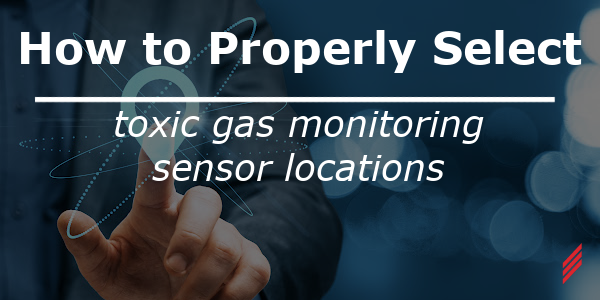How to Properly Select Hazardous Gas Monitoring Sensor Locations
by Jim Blais on Apr 25, 2019 10:33:00 AM

In addition to assessing required gas detection technologies, their capabilities (and limitations) related to safe detection of the specified hazardous gas target, proper placement and mounting location of each hazardous gas monitoring sensor is equally critical to protecting people, equipment and the facility.
Equipment Exhaust Monitoring
The ideal equipment exhaust duct penetration and mounting locations for toxic gas detection (where mechanical exhaust features permit) should include the installation of an exhaust duct sensor or extractive tubing adapters as near as possible to the following mounting locations. These locations are found to achieve optimum gas sensor detection with respect to gas leak mixing and local flow behavior within the duct:
|
Duct Feature |
Minimum Distance from Duct Feature to Gas Sample |
|
Bend or Elbow |
1 Diameter Upstream, 2 Diameters Downstream |
|
Flow Construction |
1 Diameter Upstream, 6 Diameters Downstream |
|
Exhausted Cabinet |
2 to 6 Diameters Downstream |
These ideal exhaust duct locations address the potential for “pocketing” of a gas leak. Pocketing is when an accumulation of a gas collects in a section of a ventilated enclosure and may occur if the linear velocity and mixing of airflow within the enclosure is not uniform and the gas detector is located down inside the equipment enclosure (gas cabinet, VMB, GIB).
While these monitoring locations do not eliminate potential gas pocketing from occurring, they greatly increase the likelihood of detection within the primary exhaust (i.e., the cabinet exhaust duct work). In normal operation, the primary exhaust provides the safe pathway of the “materials of concern” to carry the gas leak away from the equipment cabinet and occupied work area.
Ambient Breathing Zone Monitoring
The need for continuous ambient breathing zone gas monitoring seems subject to debate. Many facilities provide ambient monitoring and many do not. We recommend that a risk assessment be applied for each application using hazardous production materials (HPMs) addressing how each hazardous gas is stored and delivered from “source” to “use” point?
Are all the unwelded hazardous gas piping connection points and gas process components (transducers, regulators, valves, etc.) contained within a properly ventilated and exhausted housing? These include gas cabinets, valve manifold boxes, gas isolation boxes, tool cabinets and vacuum pump housings. For Any unwelded HPM gas piping connection point and component not enclosed and properly ventilated, exhausted and monitored, the risk of a potential gas leak exists.
An Example Illustrating the Challenges of Ambient Monitoring
The following outlines an actual hazardous gas incident example that promotes the need for applying ambient gas monitoring, while also illustrating the challenges associated with effective ambient gas monitoring.
The following occurred within a semiconductor fabrication facility, configured with a cleanroom bay and adjoining process equipment service chase bay arrangements.
As is typical, the service chase included diverse tool support equipment, including vacuum pumps. In this example, the vacuum pump did not have a pump containment housing and cabinet exhaust. In the event of a vacuum pump “seal failure,” hazardous gas will escape into the service chase ambient breathing zone.
The hazardous gas in this vacuum pump seal incident was arsine (AsH3), with a TWA-TLV of only 5 ppb. The relative vapor density of AsH3 is 2.7 (air = 1), with poor odor warning properties (garlic like), it immediately begins to collect near the floor (due to the service chase ventilation flow and equipment location arrangements).
The service chase was equipped with ambient hydride gas monitoring, but with extractive tubing inlet heights located at 7 to 8 feet above finished floor (so as not to interfere with periodic equipment maintenance activities).
Upon an actual leak, no detection or alarms were activated until a maintenance tool technician entered the service chase and walked through the vacuum pump leak area. This movement caused the “pooled” arsine gas near the floor to rise up around his pathway and up to an extractive gas sample tube – enabling detection, interlocks and alarming to finally occur.
Key points contributing to a lack of gas detection include:
- No containment of the tool vacuum pump via an exhausted enclosure and cabinet exhaust gas monitoring.
- Service chase ventilation did not permit the capture of the heavier than air leaking arsine gas into a chase exhaust ventilation airflow stream for detection and removal.
- Gas monitoring sample locations focused only on “lighter than air” hydride gas targets.
Ambient gas sensor mounting locations are therefore selected with consideration given to:
- Target gas properties (i.e., relative vapor density)
- Optimum locations related to the potential / possible leak points. For example, near tool gas cabinet enclosure openings (possible escaping pocketed gas), non-enclosed vacuum pumps or other exposed piping connections in the service chase or other assessed locations for maintenance activities.
- Area ventilation and ambient airflow streams and the potential changes to ventilation flows created by equipment location changes.
Effective ambient gas monitoring in selected tool service chase areas can also provide supplemental protection via notification alerts to employees involved in periodic maintenance activities (e.g., chamber cleaning, implant source housing cleaning, etc.), where potentially hazardous exposures, which cannot reasonably be controlled by other means may occur.
OSHA “Breathing Zone”
Considering the OSHA definition of a “breathing zone” as being an area within 10 inches of a workers nose or mouth; this suggests the height of a typical working employee either standing or sitting would be most representative of a “typical breathing zone”.
Using the SEMI S8 “Safety Guideline for Ergonomics Engineering of Semiconductor Manufacturing Equipment” as a reference for determining the typical working “breathing zone heights”:
- For standing individuals (eye height) placed between 53” and 69”
- For seated individuals (eye height) placed between 26” and 33”
Oxygen Deficiency Hazards
Similar continuous ambient breathing zone monitoring for safe levels of oxygen should also always be considered, examined and applied if a gas storage area, laboratory or room lacks adequate ventilation rates that cannot protect against a worst case release of large quantities of an inert gas.
Inert gases such as nitrogen, helium, argon, carbon dioxide, krypton, neon, and xenon provide no warning properties and have different expansion ratios; they may initially be heavier than air or immediately lighter than air (Helium).
A risk assessment considering the potential worst case leak scenario, the room area and available room ventilation calculations should be performed to ensure that there is no potential leak scenario that would create an atmosphere of less than 19.5% oxygen (OSHA / ACGIH definition of O2 deficiency).
If there is any question continuous ambient breathing zone oxygen monitoring should be applied with local and remote alarm notification, activating room/area evacuation and or no entry at <19.5% O2.
About the Author
Jim has retired from Hallam-ICS, but his contributions to the company continue to be valued.
Read My Hallam Story
About Hallam-ICS
Hallam-ICS is an engineering and automation company that designs MEP systems for facilities and plants, engineers control and automation solutions, and ensures safety and regulatory compliance through arc flash studies, commissioning, and validation. Our offices are located in Massachusetts, Connecticut, New York, Vermont and North Carolina and our projects take us world-wide.
You May Also Like
These Related Stories

How to Create Email Notifications Using OSIsoft PI Data Server, Rockwell Data Historian, and Microsoft SQL Server

Hallam-ICS Service Day: Middletown, CT



Comments (3)